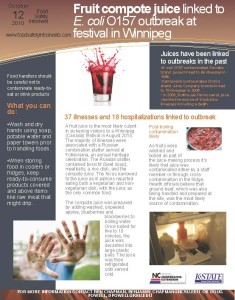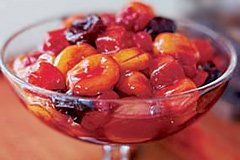In 2010, the Russian pavilion at Folklorama in Winnipeg (or, as the Guess Who were always introduced, from Winnipeg, Manitoba, Canada), was implicated in a foodborne outbreak of Escherichia coli O157 that caused 37 illnesses and 18 hospitalizations.
The ethnic nature and diversity of foods prepared within each pavilion presents a unique problem for food inspectors, as each culture prepares  food in their own unique way.
food in their own unique way.
The Manitoba Department of Health and Folklorama Board of Directors realized a need to implement a food safety information delivery program that would be more effective than a 2-h food safety course delivered via PowerPoint slides. The food operators and event coordinators of five randomly chosen pavilions selling potentially hazardous food were trained on-site, in their work environment, focusing on critical control points specific to their menu. A control group (five pavilions) did not receive on-site food safety training and were assessed concurrently. Public health inspections for all 10 pavilions were performed by Certified Public Health Inspectors employed with Manitoba Health. Critical infractions were assessed by means of standardized food protection inspection reports.
Rob Mancini, a MS graduate of Kansas State University, a health inspector with the Manitoba Department of Health, and someone who seems perpetually young with cinematic good looks (bit of a man-crush) led a study of how to improve food safety at Folklorama and the results were published in the Oct. 2012 issue of the Journal of Food Protection.
He’s at it again, and will be reporting on follow-up research he subsequently conducted with almost no help from me and Chapman at the Canadian Institute of Public Health Inspector Conference in Winnipeg, on June 24th, 2013.




 secondary spread of the E. coli bacterium. Only three of the total 40 cases were not linked to the pavilion. In addition, the report offers a number of recommendations designed to reduce the risk of E-coli outbreaks in the future.
secondary spread of the E. coli bacterium. Only three of the total 40 cases were not linked to the pavilion. In addition, the report offers a number of recommendations designed to reduce the risk of E-coli outbreaks in the future..jpg) separate pot. It was prepared by adding washed, unpeeled apples, blueberries and blackberries to boiling water. The fruit was bought fresh from a supermarket in Winnipeg.
separate pot. It was prepared by adding washed, unpeeled apples, blueberries and blackberries to boiling water. The fruit was bought fresh from a supermarket in Winnipeg.